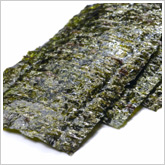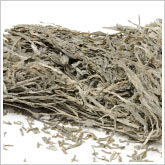Source: http://www.beachbody.com/product/nl_469.do
By Jeanine Natale
As another sultry summer shimmies into full swing, why don’t we take a look at a refreshing, versatile, and wonderfully low-calorie/fat-free food that’s sure to add an interesting new dimension to light and healthy eating? Yes, seaweed! You’ve probably seen drifts of this common sea algae floating in the ocean waves, or in tangled clumps along the beach, but did you know it’s actually a delicious, nutritious, and surprisingly popular food? If you’ve had sushi or miso soup—even salad dressing, pudding, or ice cream—odds are, you’ve eaten seaweed. Heck, you’ve probably even brushed your teeth with it.
Naturally high in essential nutrients like iodine, potassium, and magnesium, seaweed is becoming more and more available not only in health food or international stores, but also at your local market, and there are different kinds of seaweed used in all kinds of yummy dishes. It’s been a staple in the diets of many coastal cultures from Japan to Scotland for centuries, and now the rest of the world is learning how good it really is for you. Five of the varieties you’re most likely to encounter are nori, wakame, kombu, hijiki, and carrageenan, also known as Irish moss.

Contrary to many beliefs, seaweed is not fishy or even overly salty in taste or odor. Some varieties, like carrageenan, are nearly flavorless, and can be a versatile ingredient in many kinds of sweet and savory recipes. Each type of seaweed, whether crunchy, salty, chewy, sweet, crispy, or slippery, has its own nutritional fingerprint, but all varieties of this remarkable sea algae offer the health-conscious eater a fat-free, low-to-no-calorie superbundle of essential vitamins and minerals—most notably iodine.
 Iodine is perhaps best known as an ingredient added to table salt (ironically, sea salt does not contain iodine naturally). But because many of us would do well to lower our salt intake, seaweed offers an excellent low-sodium delivery system for iodine. Numerous international studies have shown that iodine plays an important role in regulating the thyroid, which helps keep your metabolism on an even keel. More importantly, according to a 2007 study by the World Health Organization, iodine deficiency is one of the world’s most preventable causes of mental retardation, with seaweed being one of the most accessible and easily digested sources of this essential mineral. Indeed, seaweed is vegan and gluten-free, and it poses much less danger of causing an allergic reaction than fish or shellfish—two other good sources of iodine—(although you should keep in mind that seaweed is often processed in the same facility as both fish and shellfish). Also gaining much worldwide attention is evidence that a diet supplemented with iodine, as well as vitamins B and E, may help in preventing or lessening the effects of fibrocystic breast disease.
Iodine is perhaps best known as an ingredient added to table salt (ironically, sea salt does not contain iodine naturally). But because many of us would do well to lower our salt intake, seaweed offers an excellent low-sodium delivery system for iodine. Numerous international studies have shown that iodine plays an important role in regulating the thyroid, which helps keep your metabolism on an even keel. More importantly, according to a 2007 study by the World Health Organization, iodine deficiency is one of the world’s most preventable causes of mental retardation, with seaweed being one of the most accessible and easily digested sources of this essential mineral. Indeed, seaweed is vegan and gluten-free, and it poses much less danger of causing an allergic reaction than fish or shellfish—two other good sources of iodine—(although you should keep in mind that seaweed is often processed in the same facility as both fish and shellfish). Also gaining much worldwide attention is evidence that a diet supplemented with iodine, as well as vitamins B and E, may help in preventing or lessening the effects of fibrocystic breast disease.
Generally, you’ll find your different types of seaweeds available as dried sheets, flakes, or leaves, in prepared packages that usually weigh a couple of ounces each. (Single-serving sizes are typically between 1 and 3 grams, depending on the recipe.) After you moisten, steep, or soak your seaweed in water according to package or recipe directions, it’s easy to use, and it retains its nutritional value even when cooked. Here’s a quick look at how the various seaweeds add up.
 Nori. The most recognizable of the seaweeds, nori comes in crunchy, paper-thin black sheets most familiarly used to wrap sushi. Nori can also be sprinkled in flake form as a yummy topping for soups and salads. A 2.5-gram serving of nori supplies 70 percent of the recommended daily allowance (RDA)* of iodine, 10 percent of the RDA of vitamin C, 8 percent of the RDA of vitamin A, and 1 gram each of protein and dietary fiber, along with trace amounts (6 percent of the RDA or less) of potassium, magnesium, riboflavin, and omegas 3, 6, and 9. Plus, each serving has just 10 calories and only 5 milligrams of sodium.
Nori. The most recognizable of the seaweeds, nori comes in crunchy, paper-thin black sheets most familiarly used to wrap sushi. Nori can also be sprinkled in flake form as a yummy topping for soups and salads. A 2.5-gram serving of nori supplies 70 percent of the recommended daily allowance (RDA)* of iodine, 10 percent of the RDA of vitamin C, 8 percent of the RDA of vitamin A, and 1 gram each of protein and dietary fiber, along with trace amounts (6 percent of the RDA or less) of potassium, magnesium, riboflavin, and omegas 3, 6, and 9. Plus, each serving has just 10 calories and only 5 milligrams of sodium. - Wakame. Generally eaten in larger amounts, wakame is a versatile seaweed most often featured as bite-sized bits in miso soup or thin slices in salad. Usually sold as dried black flakes, wakame quickly turns a beautiful jade green color when soaked in warm or hot water, with a soft, slippery, easy-to-chew texture. Wakame will add a bit more sodium to your dish than nori does (28 percent of the RDA or 660 milligrams in a 10-gram serving), but you’ll benefit from more than 100 percent of the RDA of iodine, 30 percent of the RDA of magnesium, 17 percent of the RDA of dietary fiber, 14 percent of the RDA of potassium, 8 percent of the RDA each of vitamin A, iron, and calcium, and trace amounts of riboflavin, thiamin, niacin, phosphorus, and omegas 3, 6, and 9—and it has just 25 calories.
 Kombu. Not quite as visible but essential to many delicious soups or noodle broths, kombu is a seaweed that usually comes in large dried leaves up to a foot long and a few inches wide. Typically, a cook will boil it in soups or stews, then remove it as you would a bay leaf—it imparts a hearty flavor and a decent dose of nutrients. A 3.3-gram serving of kombu has just 5 calories and 4 percent of the RDA of sodium, while also providing more than 100 percent of the RDA for iodine and trace amounts of magnesium, calcium, potassium, dietary fiber, and omegas 3, 6, and 9.
Kombu. Not quite as visible but essential to many delicious soups or noodle broths, kombu is a seaweed that usually comes in large dried leaves up to a foot long and a few inches wide. Typically, a cook will boil it in soups or stews, then remove it as you would a bay leaf—it imparts a hearty flavor and a decent dose of nutrients. A 3.3-gram serving of kombu has just 5 calories and 4 percent of the RDA of sodium, while also providing more than 100 percent of the RDA for iodine and trace amounts of magnesium, calcium, potassium, dietary fiber, and omegas 3, 6, and 9.- Hijiki. If you’re an avid fan of seaweed salads, the squeaky crunch of twig-like hijiki is already a favorite. Hijiki segments look like little dried black twigs about 1 or 2 inches in length, and soaking them in water will make them expand to about twice their size. Eaten hot or cold, hijiki has a springy, snappy crunch that is quite distinctive. A 2-gram serving of hijiki is calorie-free and supplies you with 20 percent of the RDA of calcium, trace amounts of vitamin B, magnesium, and dietary fiber, along with approximately 50 percent of the RDA of iodine.
 Carrageenan. The seaweed you hardly ever see but have probably consumed most often is known as Irish moss, listed as carrageenan on that tub of mocha marshmallow ice cream you’ve been eyeballing. (Alas, it’s not there in sufficient amounts to justify your getting to eat ice cream every day. Harrumph.) Carrageenan is mainly added to prepared foods and other products, including pudding, salad dressing, and toothpaste, to make them thick and smooth. Carrageenan can also be found at any health food store in the form of dried flakes or powder that dissolve completely in liquid, for use as a thickening agent for soups and stews or to make nutritious teas and broths. A 6-gram serving only has 25 calories and contains approximately 15 percent of the RDA of both protein and iodine, trace amounts of vitamins A, C, and B12, as well as calcium, iron, magnesium, potassium, and sodium.
Carrageenan. The seaweed you hardly ever see but have probably consumed most often is known as Irish moss, listed as carrageenan on that tub of mocha marshmallow ice cream you’ve been eyeballing. (Alas, it’s not there in sufficient amounts to justify your getting to eat ice cream every day. Harrumph.) Carrageenan is mainly added to prepared foods and other products, including pudding, salad dressing, and toothpaste, to make them thick and smooth. Carrageenan can also be found at any health food store in the form of dried flakes or powder that dissolve completely in liquid, for use as a thickening agent for soups and stews or to make nutritious teas and broths. A 6-gram serving only has 25 calories and contains approximately 15 percent of the RDA of both protein and iodine, trace amounts of vitamins A, C, and B12, as well as calcium, iron, magnesium, potassium, and sodium.
If you’re new to the wide world of edible seaweed, it’s fun—and not too expensive—to experiment with this versatile and nutritious food. Most small packages of seaweed cost anywhere from $5 to $9 for a few ounces, with larger (1-pound) bulk quantities costing anywhere from $25 or $30, up to $60 for rare or extra-fine-quality varieties. (The smaller-sized packages will provide more than enough product for your culinary needs and/or adventures.)
There are more than a few different brands out there, so read the labels carefully and go for any brand that clearly states the organic origins and farming methods of the product. Most companies that sell seaweed products offer pristine, high-quality growing conditions and ecologically friendly harvests. Again, seaweeds, by nature, are vegan and gluten-free, and are widely used in raw-food and macrobiotic diets.
Here’s one of my favorite salad recipes—perfect for summertime when chilled, and bursting with a crunchy refreshing zing when you add slivers of fresh ginger and a touch of rice wine vinegar!
Wakame and Cucumber Salad
For salad:
- 2 Tbsp. dry wakame seaweed (soak and drain according to package after measuring)
- 1/2 cucumber, sliced (scrub peel free of wax and leave on)
- 1 tsp. grated or slivered fresh ginger
For dressing:
- 1 Tbsp. low-sodium soy sauce
- 1 Tbsp. rice wine vinegar
- A few drops of agave nectar (or 1/2 tsp. sugar)
Stir dressing ingredients together until well mixed, especially if using granulated sugar. Place all ingredients in bowl and toss with dressing. Chill in tightly covered bowl. Yum! (Makes 1 serving.)
Preparation Time: 20 minutes
| Nutritional Information (per serving) | ||||||
| Calories | Protein | Carbs | Fiber | Total Fat | Saturated Fat | Sodium |
| 47 | 2 grams | 15.5 grams | 1 gram | < 1 gram | < 1 gram | 631 milligrams |
Related Articles
Questions about your workout program, diet, the latest newsletter, or anything wellness related? Chat with Steve Edwards, Beachbody Fitness Advisor, in the Beachbody Chat Room on Monday, July 25th, at 3:00 PM ET, 12:00 PM PT.
If you’d like to ask a question or comment on this newsletter article, click here to add a comment in the newsletter review section or you can email us at mailbag@beachbody.com.
Check out our Fitness Advisor’s responses to your comments in Steve Edwards’ Mailbag on the Message Boards. If you’d like to receive Steve Edwards’ Mailbag by email, click here to subscribe to Steve’s Health and Fitness Newsletter. And if you’d like to know more about Steve’s views on fitness, nutrition, and outdoor sports, read his blog, The Straight Dope.
